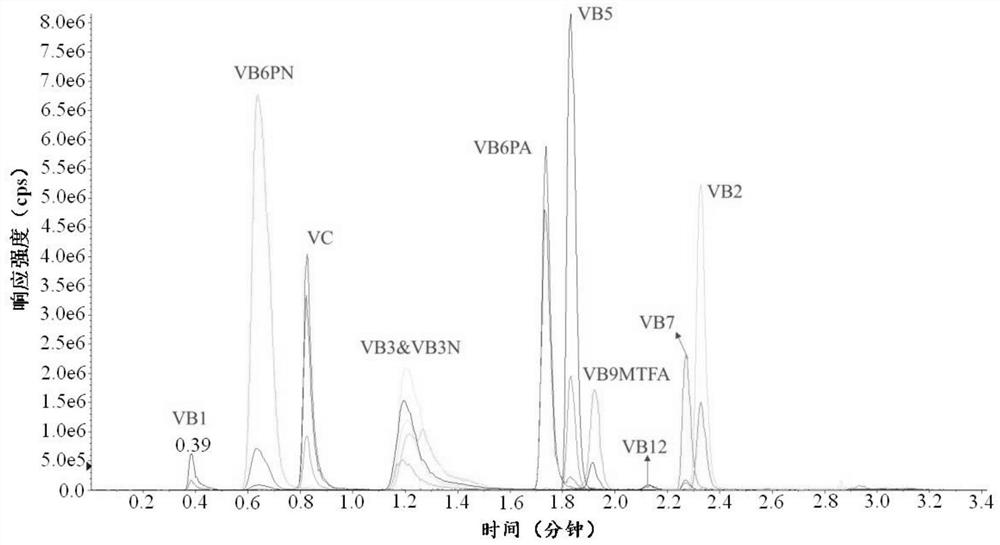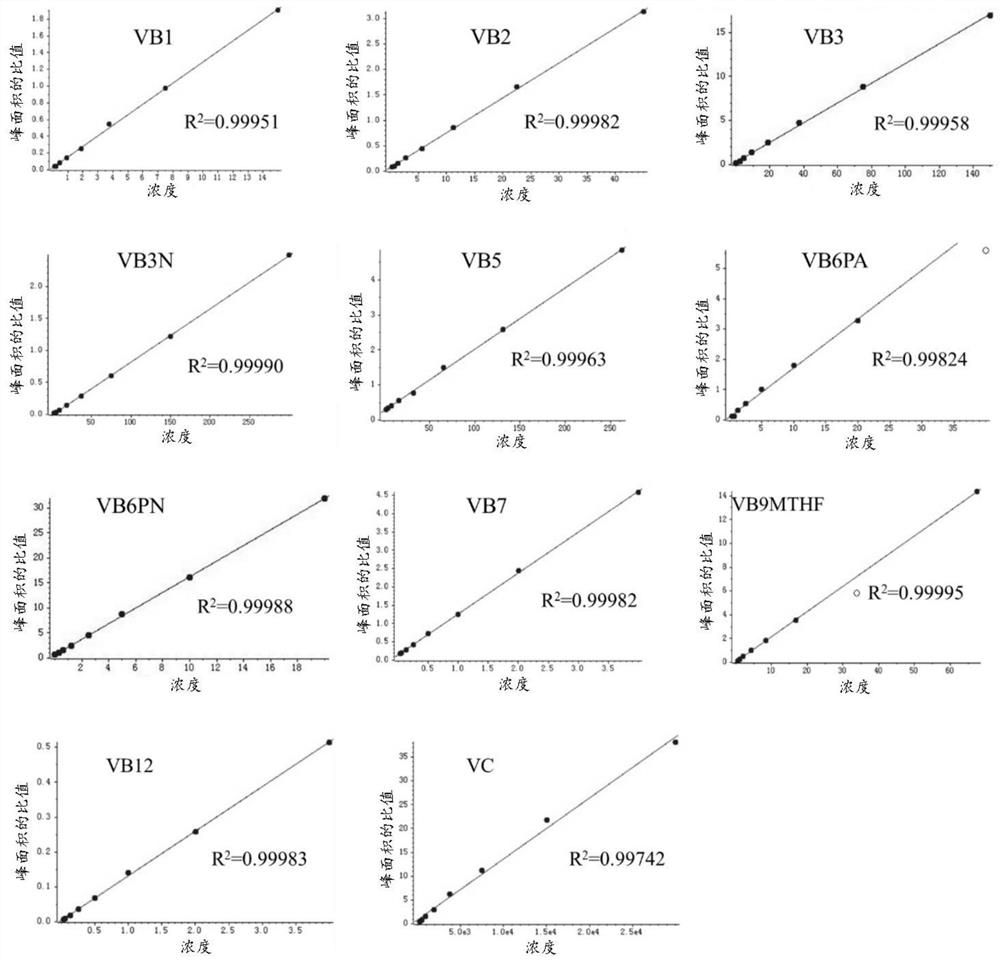Method and kit for simultaneously detecting 11 vitamins
A technology of vitamins and kits, applied in the field of vitamin detection, can solve the problems of high cost, low efficiency, and failure to meet the needs of multi-vitamins, and achieve the effect of reducing detection costs and improving detection efficiency
- Summary
- Abstract
- Description
- Claims
- Application Information
AI Technical Summary
Problems solved by technology
Method used
Image
Examples
Embodiment 1
[0047] In this example, 11 water-soluble ingredients containing thiamine, riboflavin, niacin, niacinamide, pantothenic acid, pyridoxic acid, pyridoxine, biotin, 5-methyltetrahydrofolate, cobalamin and vitamin C were used. A mixed solution of vitamins was tested as a standard. The details of the 11 water-soluble vitamins are shown in Table 3.
[0048] In this example, the method for simultaneously detecting 11 kinds of vitamins includes, when adopting liquid chromatography tandem mass spectrometry (abbreviated LC-MS / MS) to detect the sample to be tested, using an improved aqueous phase and an organic phase; wherein, the aqueous phase consists of a concentration of 0.1% Formic acid with a concentration of 2.0-5.0mM ammonium acetate and water; the organic phase is composed of formic acid with a concentration of 0.1%, ammonium acetate with a concentration of 2.0-5.0mM and an organic solvent; the organic solvent is methanol or acetonitrile.
[0049] The water-soluble vitamin detec...
Embodiment 2
[0065] In this example, on the basis of Example 1, add 30 μL of precipitant to 150 μL of the standard product for protein precipitation and water-soluble vitamin extraction, shake for 5 minutes, then centrifuge at 4000 g for 30 minutes at 4 ° C, take the supernatant, and then 4 ° C, 4000 rpm After centrifugation for 1 min, the supernatant was taken for detection by the same liquid chromatography tandem mass spectrometry as in Example 1, that is, pretreatment of the sample to be tested.
[0066] The precipitant in this example is composed of 10% sulfosalicylic acid and acetonitrile. This example analyzes and compares the influence of different volume ratios of 10% sulfosalicylic acid and acetonitrile on the precipitation and extraction effect of the target test substance, as follows:
[0067] Precipitant 1: 10% sulfosalicylic acid-acetonitrile solution with a volume ratio of 8:2;
[0068] Precipitating agent 2: 10% sulfosalicylic acid-acetonitrile solution with a volume ratio o...
Embodiment 3
[0076] In this example, on the basis of Example 1, the impact of adding different concentration ratios of ammonium acetate in the mobile phase on the target detection substance is analyzed and compared, as follows:
[0077] Mobile phase 1: water phase: ultrapure water + 0.1% formic acid, organic phase: acetonitrile + 0.1% formic acid;
[0078] Mobile phase 2: water phase: ultrapure water + 0.1% formic acid + 2.0mM ammonium acetate, organic phase: acetonitrile + 0.1% formic acid + 2.0mM ammonium acetate;
[0079] Mobile phase 3: aqueous phase: ultrapure water + 0.1% formic acid + 10.0 mM ammonium acetate, organic phase: acetonitrile + 0.1% formic acid + 10.0 mM ammonium acetate.
[0080] In this example, the mobile phases with the above three ratios were used to test the same parameters for the same samples, and some results are shown in Table 6. Table 6 only shows the results of detection of abnormal water-soluble vitamins.
[0081] Table 6 The influence of different mobile ...
PUM
 Login to View More
Login to View More Abstract
Description
Claims
Application Information
 Login to View More
Login to View More - R&D
- Intellectual Property
- Life Sciences
- Materials
- Tech Scout
- Unparalleled Data Quality
- Higher Quality Content
- 60% Fewer Hallucinations
Browse by: Latest US Patents, China's latest patents, Technical Efficacy Thesaurus, Application Domain, Technology Topic, Popular Technical Reports.
© 2025 PatSnap. All rights reserved.Legal|Privacy policy|Modern Slavery Act Transparency Statement|Sitemap|About US| Contact US: help@patsnap.com



